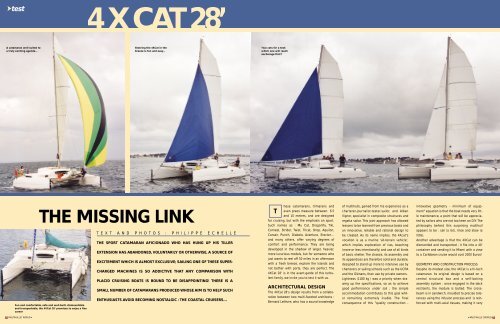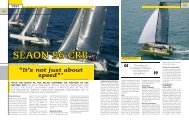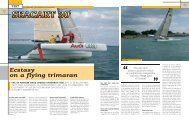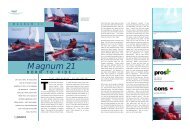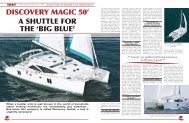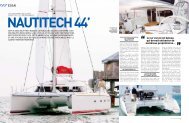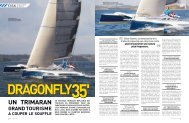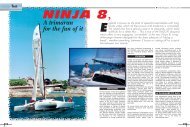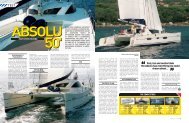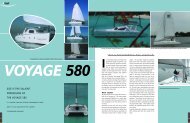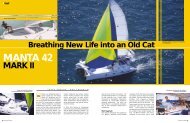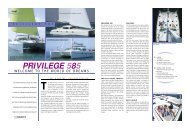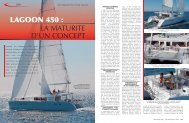62-65 - ESSAI 4XCAT 28 US - Multihulls World
62-65 - ESSAI 4XCAT 28 US - Multihulls World
62-65 - ESSAI 4XCAT 28 US - Multihulls World
You also want an ePaper? Increase the reach of your titles
YUMPU automatically turns print PDFs into web optimized ePapers that Google loves.
?test<br />
4 X CAT <strong>28</strong>’<br />
A catamaran well suited to<br />
a truly exciting agenda...<br />
Steering the 4XCat in the<br />
breeze is fun and easy...<br />
Two cats for a test:<br />
which one will reach<br />
anchorage first?<br />
THE MISSING LINK<br />
Fun and comfortable, safe and well-built, dismountable<br />
and transportable, the 4XCat <strong>28</strong>’ promises to enjoy a fine<br />
career<br />
T E X T A N D P H O T O S :<br />
P H I L I P P E E C H E L L E<br />
THE SPORT CATAMARAN AFICIONADO WHO HAS HUNG UP HIS TILLER<br />
EXTENSION HAS ABANDONED, VOLUNTARILY OR OTHERWISE, A SOURCE OF<br />
EXCITEMENT WHICH IS ALMOST EXCL<strong>US</strong>IVE; SAILING ONE OF THESE SUPER-<br />
CHARGED MACHINES IS SO ADDICTIVE THAT ANY COMPARISON WITH<br />
PLACID CRUISING BOATS IS BOUND TO BE DISAPPOINTING! THERE IS A<br />
SMALL NUMBER OF CATAMARANS PRODUCED WHOSE AIM IS TO HELP SUCH<br />
ENTH<strong>US</strong>IASTS AVOID BECOMING NOSTALGIC : THE COASTAL CRUISERS…<br />
hese catamarans, trimarans and<br />
T even praos measure between 6.5<br />
and 10 metres, and are designed<br />
for cruising, but with the emphasis on sport.<br />
Such names as : My Cat, Dragonfly, Tiki,<br />
Corneel, Strider, Twist, Tricat, Drop, Aquilon,<br />
Corsair, Punch, Diabolo, Aventura, Erector…<br />
and many others, offer varying degrees of<br />
comfort and performance. They are being<br />
developed in the shadow of larger, heavier,<br />
more luxurious models, but for someone who<br />
just wants to reel off 50 miles in an afternoon<br />
with a fresh breeze, explore the islands and<br />
not bother with ports, they are perfect. The<br />
4XCat <strong>28</strong>' is in the avant-garde of this turbulent<br />
family, we invite you to test it with us.<br />
ARCHITECTURAL DESIGN<br />
The 4XCat <strong>28</strong>'s design results from a collaboration<br />
between two multi-faceted architects :<br />
Bernard Lelièvre, who has a sound knowledge<br />
of multihulls, gained from his experience as a<br />
charterer-journalist-tester-sailor, and Alban<br />
Vigner, specialist in composite structures and<br />
regatta sailor. This joint approach has allowed<br />
lessons to be learned from previous boats and<br />
an innovative, reliable and rational design to<br />
be created. As its name implies, the 4Xcat's<br />
vocation is as a marine 'all-terrain vehicle',<br />
which implies exploration of rias, beaching<br />
(more or less intentionally) and use of all kinds<br />
of basic shelter. The chassis, its assembly and<br />
its appendices are therefore solid and durable,<br />
designed to stand up more to intensive use by<br />
charterers or sailing schools such as the UCPA<br />
and the Glénans, than use by private owners.<br />
Lightness (1180 kg ) was a priority when drawing<br />
up the specifications, so as to achieve<br />
good performance under sail ; the simple<br />
accommodation contributes to this goal whilst<br />
remaining extremely livable. The final<br />
consequence of this "quality construction -<br />
innovative geometry - minimum of equipment"<br />
equation is that the boat needs very little<br />
maintenance, a point that will be appreciated<br />
by sailors who are not too keen on DIY. The<br />
philosophy behind this surprising multihull<br />
appears to be : sail (a lot), rinse and stow (a<br />
little).<br />
Another advantage is that the 4XCat can be<br />
dismantled and transported ; it fits into a 40'<br />
container and sending it to Miami with a view<br />
to a Caribbean cruise would cost 2000 Euros!<br />
GEOMETRY AND CONSTRUCTION PROCESS<br />
Despite its modest size, the 4XCat is a hi-tech<br />
catamaran. Its original design is based on a<br />
central structural box and a self-locking<br />
assembly system : once engaged in the deck<br />
restraints, the module is bolted. The crossbeam<br />
is in sandwich, moulded to precise tolerances<br />
using the infusion process and is reinforced<br />
with multi-axial tissues, making it very<br />
<strong>62</strong> MULTIHULLS I WORLD7 3MULTIHULLS I WORLD 63
?test<br />
TEST<br />
4xCAT <strong>28</strong>’<br />
is moderate (1.31m in the centre) but six<br />
therly breeze, this promised be a fast trip and<br />
connecting rod (all the aluminium parts are of<br />
the long bowsprit, the textile spreader cables<br />
Excellent overall ergonomics for the 4XCat...<br />
Inside, it’s highly original and especially unbelievably convivial...<br />
stiff. It gives improved accommodation and<br />
means that the boat does not need a forward<br />
crossbeam, as well as having a positive effect<br />
on weight distribution. The 'egg-shaped' hulls<br />
are symmetrical (the upper and lower halves<br />
could be reversed), the 'wave piercing' bows<br />
overhang rounded V-sections which open out<br />
into a U-section towards the centre of the hull,<br />
then flatten out and increase in volume<br />
towards the stern. A pair of NACA profile fins<br />
and two compensated rudder blades complete<br />
a modern design with a strong personality.<br />
All polyester parts are made using the Scrimp<br />
infusion process, which guarantees excellent<br />
tissue to resin ratios.<br />
ACCOMMODATION<br />
I was once deeply in love with a Tiki <strong>28</strong> in<br />
wood/epoxy. This little 800kg 'bomb', perched<br />
on its superb triangular hulls and topped with<br />
a small nacelle, was beautiful beyond belief<br />
and could set me dreaming just like that, but<br />
training as a contortionist was necessary<br />
before going cruising in it. I loved the Diabolo<br />
but the lack of a central module was regrettable<br />
despite the attractions of its strip-planking<br />
construction and intelligent design. The<br />
4XCat <strong>28</strong>' offers good-sized berths in the hulls,<br />
a WC, abundant stowage space and a large<br />
nacelle which is very user-friendly. Headroom<br />
guests can be seated around the table and the<br />
two double berths (190X140cm) are really<br />
pleasant. During the day, these huge 'tatamis'<br />
will be a favourite refuge for children of all<br />
ages. Access to the hulls is by two opening<br />
panels; the two full sized berths (200 X 75cm)<br />
mean that this <strong>28</strong> footer can provide all the<br />
comfort of a cruiser, whilst retaining privacy<br />
for the crew members - especially important<br />
for long-term family cruising. The huge, unobstructed<br />
cockpit (3.50 X 2m) is equipped with a<br />
table (an extension of the engine locker) and<br />
access to the water is practical : there are two<br />
steps in the transoms and a bathing ladder.<br />
The care taken with the overall ergonomics<br />
favours the quality of life and safety aboard.<br />
ENGINE<br />
The 10 hp Honda 4-stroke, with electric start<br />
and gearbox controls in the cockpit, is perfectly<br />
suited to the 4XCat <strong>28</strong>', there is sufficient<br />
power and torque. Linking the tiller to the<br />
motor (by a small line) greatly improves<br />
manoeuvrability. The outboard bracket is<br />
adjustable using a block and tackle and is easy<br />
to use ; its shape means that it can also house<br />
the petrol tank, thus improving security, as any<br />
possible fumes or leaks will not spill into the<br />
boat. A tip-up locker gives access. Overall, this<br />
installation has been well thought out and<br />
meticulously built.<br />
DECK PLAN AND FITTINGS,<br />
RIG<br />
An 11.8m wing mast and a long removable<br />
bowsprit for the 30 sq m gennaker or the 56 sq<br />
m asymmetric spinnaker account for the<br />
'power' side of things ! The self-tacking jib is<br />
there just for ease of use and comfort in<br />
strong winds. Add to this an 'Arthur' for turning<br />
the mast, a central winch, a jib sheet with<br />
jammer and two spinnaker or gennaker sheets<br />
: the 4Xcat's deck plan is simple and rational!<br />
The loose-footed mainsail has no boom<br />
(advantageously replaced by a lower batten),<br />
and the 8-part tackle is quite sufficient. The<br />
mainsheet traveller slides in a long track guaranteeing<br />
accurate adjustment and rapid reactions<br />
in strong winds<br />
DYNAMIC TEST<br />
We left le Crouesty at the beginning of the<br />
afternoon for a return trip towards the Ile<br />
d'Houat. With a moderate (10-16 knots) nor-<br />
would give interesting conditions on all points<br />
of sailing, including close-hauled on the way<br />
back.<br />
For this test we had two 4XCat <strong>28</strong>'s, the builder's<br />
demonstration boat and the latest model<br />
delivered ; these two 'Raid' versions were<br />
equivalent, apart from the fact that the first<br />
had an asymmetric spinnaker and the second,<br />
aboard which I was sailing, was equipped with<br />
a gennaker. After leaving le Crouesty, we hoisted<br />
it and immediately went into the lead ;<br />
with a light breeze on the beam, we were at a<br />
steady 9 knots under a cloud covered sky. The<br />
crew consisted of four adults and two children,<br />
with equipment for 'extended' cruising<br />
(dinghy, two anchors and warps, food, kitbags<br />
and various other equipment) as we had chosen<br />
to carry out this test as if we were sailing<br />
as a family. First comments : the trim was perfect<br />
and the load carrying capacity amazing ;<br />
the deck arrangements and the overall space<br />
available mean that family cruising is a realistic<br />
proposition. Performance, which logically<br />
should have been seriously reduced, remained<br />
good and the boat was well-balanced. On<br />
a reach, the 4Xcat's speed approached that of<br />
the wind (12 knots) and its balance remained<br />
exemplary. The two tillers are linked by a rigid<br />
As an option,<br />
the hulls can be converted<br />
With her 10HP Honda<br />
4-stroke motor with electric<br />
starter and inverter<br />
controls, the 4XCat has<br />
sufficient motor power<br />
very high quality : baked white epoxy finish,<br />
perfect welds). The boat was easy to trim and<br />
the Incidences sails were up to their usual<br />
high standard. I freed the gennaker a little to<br />
bear away under power; driving the 4XCat<br />
over the chop which was starting to form :<br />
the 'feel' of the helm owes much to the rudders'<br />
compensation, they are precise and<br />
light but their directional effect is responsive<br />
and powerful. We rode over short waves at<br />
between 12 and 13 and a half knots for a long<br />
time (the wind offshore was now stronger)<br />
then, as Houat was approaching very rapidly,<br />
it was time to heave to and wait for the other<br />
4XCat. They hoisted their spinnaker and 5<br />
minutes later, were flying towards us at 15<br />
knots. We rehoisted the gennaker and did<br />
what we could, but the 56m2 of spinnaker<br />
revealed the superior potential of the other<br />
4XCat. With the weight just taken off the<br />
windward hull, the extra power meant it surfed<br />
earlier and further; in perfect trim, with its<br />
bows 'smoking' and everyone aboard relaxed<br />
(there were even crew members on the trampoline!)<br />
the boat was a beautiful sight.<br />
I did what I could to catch up with our sister<br />
ship, but it continued to draw ahead steadily,<br />
confirming the evidence : to go fast on all<br />
points of sailing, both a spinnaker and a gennaker<br />
are necessary. As we approached the<br />
long beach on Houat, we gybed onto a reach<br />
under a heavy sky and with a 16 - 17 knot<br />
breeze. This is without a doubt one of the<br />
4XCat's preferred points of sailing. With the<br />
gennaker sheeted in and the main fairly<br />
open, it revealed another side to its character<br />
: perfectly balanced (hands off, tiller amidships)<br />
and doing 13 knots at 70-80° to the<br />
wind whilst remaining perfectly stable. In<br />
these conditions (which were strengthening),<br />
the fittings showed no signs of weakness :<br />
Welcome onboard...<br />
and the mast itself gave no evidence of being<br />
under stress. Even more surprising, and indicative<br />
of the build quality was the fact that<br />
there were no creaking or cracking noises to<br />
be heard. The homogenous nature of the<br />
chassis was becoming apparent during this<br />
test. After this last charge, which left our colleagues<br />
for dead (as they could not luff up,<br />
they had been obliged to take the spinnaker<br />
down), we covered the last few miles to<br />
windward under jib, before crossing the Golfe<br />
du Morbihan towards Logeau to anchor one<br />
of the boats. The return trip against 7 - 8<br />
knots of current proved that the little Honda<br />
was perfectly adequate. The night spent on<br />
board confirmed the excellent sleeping<br />
arrangements.<br />
CONCL<strong>US</strong>ION<br />
The 4XCat is a cleverly designed, modern <strong>28</strong><br />
footer whose general balance, spaciousness<br />
and build quality mean that it can be considered<br />
as a true cruising multihull. Its seakeeping<br />
qualities are hard to fault ; the same can<br />
be said for its safety, both active and passive<br />
(1600l of buoyancy in 4 compartments, made<br />
up of 35 kg/m3 PU foam blocks, rather than<br />
ordinary expanded foam, which absorbs<br />
water !) ; during the insubmersibility test, full<br />
of water and with the crew aboard, the nacelle<br />
was still 30cm from the surface! For performance<br />
enthusiasts, with 59m2 under gennaker<br />
or 85 with the spinnaker, for an all-up<br />
weight of 1300kg, there is plenty of power!<br />
Speed fanatics and regatta sailors will choose<br />
the ‘Formula’ version, which is lighter,<br />
equipped with daggerboards and must be<br />
amazing.<br />
The 4XCat<strong>28</strong>' is both entertaining and comfortable,<br />
safe and well built; it can be dismantled<br />
and transported (on a trailer designed<br />
by the architects) and merits a long<br />
career. Its versatility and wide range of use<br />
should snowball and bring a different kind of<br />
simple, 'fun' cruising back into popularity; it<br />
could even become a trend! My personal<br />
choice would be a ‘Formula’ version with textile<br />
rigging, a cruising pack with a watermaker<br />
and bright red laquered hulls like VICTORINOX<br />
! But I am absolutely certain that the ‘Raid’<br />
version has sufficient potential for a shorthanded<br />
crew, as long as it is not overloaded.<br />
<strong>4XCAT</strong> <strong>28</strong>’<br />
Pros<br />
➤ Innovative architecture<br />
➤ Build and equipment quality<br />
➤ Easy to use<br />
Cons<br />
➤ The design was not the result of a consensus of opinion<br />
➤ Slight lack of power to windward in a moderate<br />
breeze (to do with the non-overlapping jib)<br />
SPECIFICATIONS<br />
➤Architects : Bernard Lelièvre and Alban Vigner-<br />
ADN<br />
➤Builders : for the Polyester, VIP Composites<br />
(Olonne/mer), for final assembly and finishing, ADN<br />
➤Materials : Divinycell 80 foam/multi-axial<br />
glass/vinylester (or epoxy for the Formula version )<br />
sandwich, Scrimp - infusion process.<br />
➤Length : 8.49m<br />
➤Waterline length : 8.40m<br />
➤Beam : 5.30m<br />
➤Unladen displacement : 1180 kg<br />
➤Permitted load : 680 kg in category D, 610kg in<br />
category C<br />
➤Mainsail : 29.5m2 + 2.16m2 wing mast<br />
Jib : 11.5m2<br />
➤Asymmetric spi : 56m2<br />
➤Gennaker : 30m2<br />
➤Engine : 10 to 20 hp on lifting bracket or 2X10<br />
hp IB Diesel<br />
➤Draft : 0.<strong>65</strong>m with fins, 0.35/1.60m with daggerboards<br />
➤Accommodation : 2 double berths + 2 single<br />
berths + saloon + galley<br />
➤Category : 5 persons in category C, 6 in cat. D<br />
The boat is unsinkable and can be dismantled and<br />
transported.<br />
➤Price : 59 499 euros, tax not included,<br />
standard version<br />
Options on the version tested, price not<br />
including tax, in euros :<br />
➤Bowsprit and fittings : 735 euros<br />
➤Gennaker : 923 euros<br />
➤Honda 10 hp outboard with controls :<br />
3 115 euros<br />
➤Hull berths : 416 euros for 2<br />
➤WC with holding tank : 766 euros<br />
➤Hull portholes, class I : 593 euros<br />
64 MULTIHULLS I WORLD7 3MULTIHULLS I WORLD <strong>65</strong>


